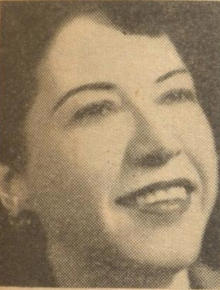Grace Gibson
Grace Gibson AO | |
|---|---|
 Grace Gibson, c.1947 | |
| Born | Grace Isabel Gibson 17 June 1905 |
| Died | 10 July 1989 (aged 84) |
| Other names | Grace Atchison, Grace Parr |
| Occupation(s) | Radio executive, producer, entrepreneur |
Grace Isabel Gibson AO, (17 June 1905 – 10 July 1989), also known as Grace Atchison and Grace Parr was an American Australian radio entrepreneur, executive and producer. She was best known for her long-running serials Dr. Paul and the local version of NBC hit Portia Faces Life.[1]
Biography
[edit]Gibson was born in El Paso, Texas, USA, in 1905 to Calvin Newton Gibson and Mexican Margaret Escobara (Schultz) and finished her schooling in California. She started her career in her native US working for the Radio Transcription Company of America, as a distributor of radio programs, when recruited by Alfred Bennett, general manager of Sydney radio station 2GB, who was visiting the United States. Together they set up American Radio Transcription Agencies (later Artransa Pty Ltd), which sold American recorded radio programs throughout Australia, and Gibson moved to Sydney, Australia in 1934.
Gibson was on a buying trip in the US in 1941 when Pearl Harbor was attacked, and as a result she was prevented from returning to Australia for several years. Whilst stranded she became manager of her former company, Radio Transcription Company of America.[2]
In 1944 set up her own company, Grace Gibson Radio Productions Pty. Ltd., based in Savoy House, Bligh Street, Sydney. The company would become one of the biggest producers of radio drama with broadcast productions that would air in Australia, New Zealand, South Africa, Hong Kong and Canada.[3] Her company produced over 30,000 programs for Australian radio.[4]
The company's first show was the documentary series Here are the Facts. That was followed by a number of popular daytime soap operas and other shows such as Doctor Paul, Portia Faces Life, Night Beat, Dossier on Dumetrius, Cattleman, I Christopher Macauley, Chickenman, Chuck Chunder, Captain Kremmen, and Mr. and Mrs. North.[1]
Gibson continued to produce radio dramas from her Australian headquarters for the South African market until as late as 1971, long after television had replaced radio as the main place to hear drama in the home in most countries. This was because South Africa was virtually the last place in the English-speaking world to introduce television.[5]
She retired in 1978 and sold Grace Gibson Radio Productions Pty. Ltd. in the same year.[1]
Gibson was awarded the Medal of the Order of Australia (AO) in 1987 in recognition of her services to radio in Australia. Gibson was three times married and died in 1989 in Potts Point, aged 84.
Select Shows - Producer
[edit]- Cattleman (1961)
- Two Roads to Samara, radio play thriller (1959)
- The Smell of Terror, radio play thriller (1959)
- Knave of Hearts, radio play humour (1958)
- A Mask for Alexis, radio play crime (1957-1958)
- A Stranger in Paradise, radio play crime (1956)[6]
- They Were Champions, drama series about sports champions (1952)
References
[edit]- ^ Jump up to: a b c Grace Gibson Productions, austlit.edu.au. Retrieved 25 August 2024.
- ^ Lane, Richard and National Film and Sound Archive of Australia, 1994, The Golden Age of Australian Radio Drama 1923-1960: A History Through Biography, Melbourne University Press, Carlton South, Vic
- ^ Murphy, Lynne, 'Gibson, Grace Isabel (1905–1989)', Australian Dictionary of Biography, National Centre of Biography, Australian National University accessed 5 February 2012
- ^ "Yanks Down Under (film)". Australian Screen: An NFSA Website. 1983. Retrieved 29 September 2023.
- ^ "The history of television in SA". 4 December 2014.
- ^ "Grace Gibson Productions : Works by". AustLit. 10 February 2015. Retrieved 29 September 2023.
Further reading
[edit]- Richard Lane, The Golden Age of Australian Radio Drama 1923-1960 : A History through Biography, Canberra, Australian Capital Territory: National Film and Sound Archive; and Carlton, Victoria: Melbourne University Press, 1994
External links
[edit]- Remembering Grace Gibson with Vintage Radio Dramas at National Film and Sound Archive
- Read more about Grace Gibson, and listen to an oral history interview done with her on the National Film and Sound Archive of Australia's website.
- Women in Early Radio in Australia at National Film and Sound Archive
- Gibson, Grace Isabel at Australian Women's Register
- Moran, Albert ‘Some beginnings for Australian television’, Continuum: The Australian Journal of Media & Culture, 1991, Vol. 4 No. 2
- Dr Paul, Popular Radio Serial at radioheritage.net
- Series: Dr Paul at radioechoes.com
- Doctor Paul at offshoreradiomuseum.co.uk
- Portia Faces Life and Dr Paul (from the Fifties) at elsewhere.co.nz
- Dr Paul: Radio's Great Story of Adult Love on YouTube
- Complete episodes of Dossier on Dumetrius on Wayback Machine
- Grace Gibson Radio Retail Store - online store which sells radio serials, dramas and comedies from Grace Gibson Productions
- Radio Soaps: Blue Hills (1949–76), Yes, What? (1936–40), Dr Paul (1949–70) and Portia Faces Life (1952–70) - commentary by Tim Bowden
